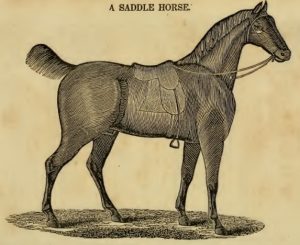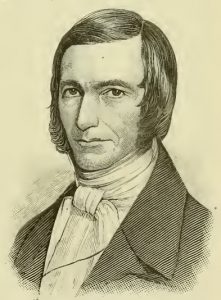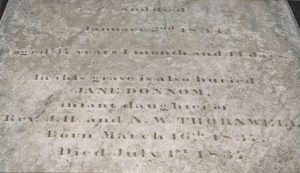 On April 8, 1835, Bethel Presbytery organized its new church in Lancaster, South Carolina. The church needed a teaching shepherd, so elders who had seen James Thornwell examined for licensure encouraged the congregation to approve presenting him a call through presbytery. On June 12, 1835, after some soul-searching about his spiritual qualifications and calling to the ministry, Thornwell was ordained for the gospel ministry and installed the pastor of the Lancaster congregation. In conjunction with his call to Lancaster he also ministered to two other churches located at Six Mile Creek and Waxhaw. B. M. Palmer, Thornwell’s biographer, commented that the young minister “resided in the village of Lancaster, where a neat church building was soon erected under his auspices. The Waxhaw Church was distant about eight miles; and the Six-Mile charge, about eighteen miles.” The simple roads of the era did not facilitate rapid travel by any method, but young Thornwell was able to cover the distance quickly thanks to his horse “Red Rover” that was “habitually driven at the speed of ten and twelve miles an hour.” As pastor of the three country congregations, he inevitably spent considerable time in the saddle and must have born the physical marks from riding his galloping mount.
On April 8, 1835, Bethel Presbytery organized its new church in Lancaster, South Carolina. The church needed a teaching shepherd, so elders who had seen James Thornwell examined for licensure encouraged the congregation to approve presenting him a call through presbytery. On June 12, 1835, after some soul-searching about his spiritual qualifications and calling to the ministry, Thornwell was ordained for the gospel ministry and installed the pastor of the Lancaster congregation. In conjunction with his call to Lancaster he also ministered to two other churches located at Six Mile Creek and Waxhaw. B. M. Palmer, Thornwell’s biographer, commented that the young minister “resided in the village of Lancaster, where a neat church building was soon erected under his auspices. The Waxhaw Church was distant about eight miles; and the Six-Mile charge, about eighteen miles.” The simple roads of the era did not facilitate rapid travel by any method, but young Thornwell was able to cover the distance quickly thanks to his horse “Red Rover” that was “habitually driven at the speed of ten and twelve miles an hour.” As pastor of the three country congregations, he inevitably spent considerable time in the saddle and must have born the physical marks from riding his galloping mount.
Another change in Rev. Thornwell’s life came through his new ministry when he was able to spend time with Nancy Witherspoon. Nancy’s father, Colonel James H. Witherspoon,  was a prominent and respected man in the district. Thornwell’s opportunities to visit Nancy were facilitated by his friendship from his college days with two of her brothers. The courting was short lived given that James and Nancy were married on December 3, 1835, which was less than six months after his ordination. B. M. Palmer noted that the previously mentioned steed, Red Rover, was thought by Nancy’s friends and family to be too dangerous to pull a carriage with her as a passenger, so James sold the magnificently fast but contrary horse because of his concern for her safety. Nancy and James enjoyed their new marriage living in her father’s home following the recent death of Mrs. Witherspoon. Palmer said of the young minister that “no man had better reason to know the truth of Solomon’s assertion that a prudent wife is from the Lord.”
was a prominent and respected man in the district. Thornwell’s opportunities to visit Nancy were facilitated by his friendship from his college days with two of her brothers. The courting was short lived given that James and Nancy were married on December 3, 1835, which was less than six months after his ordination. B. M. Palmer noted that the previously mentioned steed, Red Rover, was thought by Nancy’s friends and family to be too dangerous to pull a carriage with her as a passenger, so James sold the magnificently fast but contrary horse because of his concern for her safety. Nancy and James enjoyed their new marriage living in her father’s home following the recent death of Mrs. Witherspoon. Palmer said of the young minister that “no man had better reason to know the truth of Solomon’s assertion that a prudent wife is from the Lord.”
 One of the tragedies of the Thornwells’ marriage occurred when their first born child died. The inscription on the grave marker in the Waxhaw Presbyterian Church cemetery commemorating the girl’s brief life reads, “In this grave is also buried / JANE DONNOM, / infant daughter of / Rev. J. H. and N. W. Thornwell, / Born March 16th, 1837, / Died July 1st, 1837.” The infant was interred with her maternal grandmother who had died January 2, 1834 at the age of 47 years, 4 months, and 14 days. Even though infants commonly died in those days, the high infant mortality rate yielded little comfort through common experience to those who saw their children suffer and die after only a few months.
One of the tragedies of the Thornwells’ marriage occurred when their first born child died. The inscription on the grave marker in the Waxhaw Presbyterian Church cemetery commemorating the girl’s brief life reads, “In this grave is also buried / JANE DONNOM, / infant daughter of / Rev. J. H. and N. W. Thornwell, / Born March 16th, 1837, / Died July 1st, 1837.” The infant was interred with her maternal grandmother who had died January 2, 1834 at the age of 47 years, 4 months, and 14 days. Even though infants commonly died in those days, the high infant mortality rate yielded little comfort through common experience to those who saw their children suffer and die after only a few months.
As young Thornwell’s ministry continued, he attended his first general assembly meeting as a minister and commissioner for Bethel Presbytery in 1837. He arrived on the ninth day of the proceedings and continued in attendance, it is believed, until adjournment. The reason for his late arrival may have been the frail condition of his baby daughter and his deep concern for both mother and child. The lengthy assembly in 1837, which convened on May 18th and adjourned on June 8th, was due to considerable business associated with what would result in two separate Presbyterian churches, each using the same official name but known commonly as the Old School and the New School. Thus, young Thornwell found himself in his first assembly in one of the longest and most heated meetings of the judicatory in the denomination’s history. The Presbyterian Church had been suffering theologically from the effects of their Plan of Union with the New England Congregationalists in 1801. The increasing influence of the New England Theology had contributed to an erosion of commitment to the Westminster Confession and its catechisms, thus the Old School, those who held to full subscription to the Westminster Standards, were seeking to remove the New School whose confessional commitment was limited. It is known that as the assembly progressed in its early meetings it became clear the issues would be crucial for the future of the church, and the members on both sides called for absent commissioners to attend at all costs and increase the numbers voting. Undoubtedly, Rev. Thornwell attended in the midst of his difficulties because he realized the importance of his vote as a minister representing the Old School views. It must have been a difficult time for Thornwell as he participated in the proceedings with his thoughts on his family. Following his attendance in Philadelphia, he returned home where in less than a month his and Nancy’s infant daughter would die.
 The Thornwells’ stay in the area of Lancaster would be a brief residence. On January 1, 1838, James would become the Professor of Logic and Philosophy at South Carolina College (currently, University of South Carolina) where he would remain until he was called to be the pastor of First Presbyterian Church, Columbia, on January 1, 1840. He would spend most of the remainder of his brief life in Columbia preaching in the marble pulpit of First Presbyterian Church, serving in various capacities at South Carolina College, and instructing divinity students at Columbia Theological Seminary. He was moderator of the meeting of the Old School General Assembly of the Presbyterian Church in the United States of America in 1847.
The Thornwells’ stay in the area of Lancaster would be a brief residence. On January 1, 1838, James would become the Professor of Logic and Philosophy at South Carolina College (currently, University of South Carolina) where he would remain until he was called to be the pastor of First Presbyterian Church, Columbia, on January 1, 1840. He would spend most of the remainder of his brief life in Columbia preaching in the marble pulpit of First Presbyterian Church, serving in various capacities at South Carolina College, and instructing divinity students at Columbia Theological Seminary. He was moderator of the meeting of the Old School General Assembly of the Presbyterian Church in the United States of America in 1847.
James Henley Thornwell died in Charlotte, North Carolina, August 1, 1862, four months and eight days short of his fiftieth birthday. He is buried in Elmwood Cemetery, Columbia, South Carolina, in a plot given to him by his friend and colleague, B. M. Palmer. His grave is marked with the briefly inscribed and simple monument that reads, “James Henley / Thornwell / Aged 50 Years.” Buried beside him is Nancy, who survived him by nearly three decades dying on June 11, 1891. On her  memorial is inscribed, after the customary vital dates information, the sentiment, “She was a good woman and full of / the Holy Ghost.” Also buried in the plot are three more children whose brief lives exemplify the difficulties of Victorian living—Jackson Witherspoon Thornwell, who died one day short of 8 years and 8 months; Nannie Witherspoon Thornwell, who died at the age of 20 years, 6 months, and 1 day; and Gillespie Robbins Thornwell, who died in his nineteenth year as one of the multitude of casualties in the Civil War.
memorial is inscribed, after the customary vital dates information, the sentiment, “She was a good woman and full of / the Holy Ghost.” Also buried in the plot are three more children whose brief lives exemplify the difficulties of Victorian living—Jackson Witherspoon Thornwell, who died one day short of 8 years and 8 months; Nannie Witherspoon Thornwell, who died at the age of 20 years, 6 months, and 1 day; and Gillespie Robbins Thornwell, who died in his nineteenth year as one of the multitude of casualties in the Civil War.
BY BARRY WAUGH
Sources—The portrait of Thornwell is from Nevin’s encyclopedia of the Presbyterian Church and the grave pictures were taken by the author; the title page of the South Carolina College catalog and the image of the “Saddle Horse” found in The Gentleman’s New Pocket Farrier…The Horse, 1841, are from digital books on Internet Archive. The South Carolina Catalog has Thornwell listed as the president. The pages used from B.M. Palmer’s biography, The Life and Letters of James Henley Thornwell D.D., LL.D., reprinted by Banner of Truth, 1974, 1986, are 134-137. Dr. C. N. Willborn provided the information regarding Thornwell’s grave having been given to him by B. M. Palmer. This article was first published beginning on page 276 of The Confessional Presbyterian 8, 2012, under the title, “James Henley Thornwell’s First Pastoral Ministry at the Waxhaw Presbyterian Church.” Information regarding this issue of The Confessional Presbyterian can be accessed by clicking HERE. For more information regarding the Old School and the New School that is available on Presbyterians of the Past, click HERE.
Notes—Thornwell was ordained June 1835, so he could not have been a commissioner to that assembly because it convened May 21, 1835 in Pittsburgh. The author has concluded that Thornwell did not attend the 1836 assembly from information in the excerpt from Thornwell’s personal journal found in Palmer’s Life and Letters of James Henley Thornwell, 139-140, particularly the May 14th entry, and because he is not listed as a commissioner to the 1836 meeting in Minutes of the General Assembly of the Presbyterian Church in the United States of America with an Appendix, A.D. 1836, Philadelphia: Published by the Stated Clerk of the Assembly, 1836, page 6. Thornwell is known to have been a commissioner in 1837 because his arrival on the 9th day is listed in the roll of commissioners in the published Minutes of the General Assembly of the Presbyterian Church in the United States of America: With an Appendix, A.D. 1837, Philadelphia: Published by the Stated Clerk of the Assembly, 1837, page 414.





